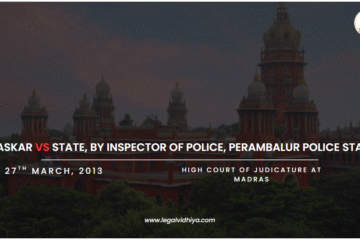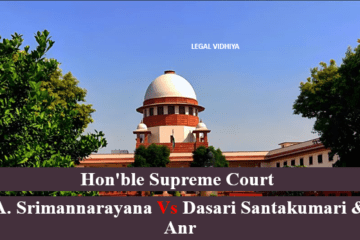
| Jurisdiction | Criminal Appeal No 1643 of 2013 |
| Date of Judgment | 08 October, 2013 |
| Court | Supreme Court of India |
| Appellant | Kunwar pal |
| Respondent | State of Uttarakhand |
| Bench | B.S. Chauhan, S.A. Bobde |
| Citation | S.L.P (Crl.) No. 2792 |
Facts of the Case:
On May 22, 1998, during a marriage ceremony in Uttarakhand, a tragic incident unfolded. Kunwar Pal, one of the attendees, carried a double-barrel gun meant for celebratory firing. Several others at the event were also armed with firearms for the same purpose. However, during the celebration, despite warnings against it, shots were fired. One of these shots struck Ramayan Prasad, causing a fatal injury that led to his death.
Kamlesh Kumar, Ramayan Prasad’s nephew, filed the First Information Report (FIR) accusing Kunwar Pal and two others of firing the shots, which resulted in the death of his uncle. The charges were filed under Section 304 of the Indian Penal Code (IPC), dealing with culpable homicide not amounting to murder.
Issues Presented:
- Determining whether Kunwar Pal was responsible for the shot that caused Ramayan Prasad’s death.
- Establishing whether there was intention or knowledge on the part of Kunwar Pal to cause harm or death by firing the gun during the celebration.
- Assessing the appropriate section of the IPC under which Kunwar Pal should be convicted based on the evidence and circumstances.
ARGUMENTS OF PETITIONER
- Kunwar Pal argued that there was a lack of conclusive evidence directly linking the fatal shot to his gun. Despite multiple individuals firing during the celebration, the evidence did not definitively identify the specific source of the shot that caused Ramayan Prasad’s death. The petitioner emphasized the need for clear evidence to establish culpability.
- The petitioner contended that there was no apparent motive for intending to cause harm or kill Ramayan Prasad. The act of carrying a double-barrel gun to the celebration was not indicative of malicious intent, and there was no demonstrated motive to target the deceased. Kunwar Pal argued that mere possession of a firearm does not imply an intention to commit a crime.
- Kunwar Pal pointed out inconsistencies and ambiguities in the witness testimonies. The witnesses did not provide a uniform account of the events, making it challenging to establish a clear sequence of actions and accurately attribute the fatal shot. The petitioner argued that these inconsistencies raised doubts about the accuracy and reliability of the witness statements.
- The petitioner stressed that there was no direct eye-witness testimony linking him to the fatal shot. No witness explicitly stated that they saw Kunwar Pal firing the shot that caused Ramayan Prasad’s death. The absence of direct eye-witness testimony undermined the prosecution’s claim of the petitioner’s direct involvement.
- Kunwar Pal argued that the investigation conducted was inadequate and lacked diligence. The failure to consult a Ballistic Expert and obtain a comprehensive ballistic report further weakened the case. The petitioner contended that a proper investigation was crucial to ascertain the precise origin of the fatal shot.
ARGUMENTS OF RESPONDENT
- The respondent argued that Kunwar Pal carrying a double-barrel gun to the celebratory event indicated an intention to cause a ruckus and potentially harm individuals present. The act of bringing a firearm to a gathering implied a purpose beyond mere celebration, reflecting a disregard for the safety of others.
- The prosecution highlighted that despite warnings against firing, shots were indeed fired during the celebration. Kunwar Pal and others disregarded these warnings and fired their guns, leading to the unfortunate incident. This demonstrated a lack of concern for the safety of attendees and showcased an intention to cause harm.
- The respondent argued that being in possession of the firearm directly linked Kunwar Pal to the incident. Given the inherent danger associated with discharging firearms, carrying one implies a level of responsibility. Kunwar Pal’s possession and use of the gun during the celebration made him accountable for the consequences.
- The prosecution contended that Ramayan Prasad’s death was a direct result of the firearm discharge during the celebration. Kunwar Pal, being one of the individuals firing the gun, shared culpability for the death. The act of firing in a crowded area showed a reckless disregard for human life.
- The respondent argued that the tragedy could have been prevented had Kunwar Pal and others exercised caution and refrained from firing in a crowded setting. The act of firing a gun in such circumstances exhibited a lack of prudence and care, directly contributing to the unfortunate loss of life.
- The prosecution acknowledged that celebratory gunfire might be a local practice. However, they argued that even if it was a norm, individuals carrying firearms should exercise caution and restraint, ensuring the safety of those around them. Failure to do so demonstrated recklessness.
JUDGEMENT
- The Court examined the evidence presented during the trial, including witness testimonies and the circumstances surrounding the incident. It noted that there was a lack of conclusive proof linking the fatal shot to Kunwar Pal’s gun.
- The defense successfully raised doubts about the conclusive link between the shot that caused Ramayan Prasad’s death and the gun fired by Kunwar Pal. The Court recognized the challenge in pinpointing the exact source of the fatal shot amidst multiple individuals firing during the celebration.
- The Court considered the absence of a clear motive or intent on the part of Kunwar Pal to cause harm or kill Ramayan Prasad. The act of carrying a double-barrel gun to a celebratory event was not seen as sufficient evidence of malicious intent.
- The Court acknowledged the defense’s argument regarding the inadequate and careless investigation. The failure to consult a Ballistic Expert and obtain a comprehensive ballistic report was seen as a weakness in the prosecution’s case.
- The Court noted the inconsistencies and ambiguities in the witness testimonies. It highlighted that these inconsistencies raised doubts about the accuracy and reliability of the witness statements.
- The Court considered the appropriate section of the Indian Penal Code (IPC) under which Kunwar Pal should be convicted. Based on the evidence and circumstances, the Court held the appellant guilty under Section 304 Part II of the IPC, dealing with causing death with knowledge that the act is likely to cause death.
- The Court, while recognizing the seriousness of the incident, reduced Kunwar Pal’s sentence from the original conviction to 7 years of imprisonment. The Court emphasized responsible handling and use of firearms, particularly in celebratory events, to prevent tragic incidents.
In conclusion, the case of Kunwar Pal vs. State of Uttarakhand revolved around a tragic incident during a marriage ceremony in 1998. The appellant, Kunwar Pal, and others were armed with double-barrel guns meant for celebratory firing. Despite warnings, shots were fired, and one of them struck Ramayan Prasad, resulting in his death.
The case presented a central challenge: establishing a direct link between the fatal shot and Kunwar Pal’s gun. The defense emphasized this crucial point, highlighting the lack of conclusive evidence to attribute the shot definitively.
Furthermore, the defense argued against establishing intent or malice, stating that carrying a firearm to a celebratory event did not inherently suggest an intention to cause harm. They pointed to the absence of a clear motive.
The prosecution argued that Kunwar Pal’s act of carrying a firearm to the event demonstrated a reckless attitude and disregard for the safety of others. They emphasized the violation of warnings against firing and contended that the tragedy was preventable had caution been exercised.
Ultimately, the court considered the lack of concrete evidence linking Kunwar Pal to the fatal shot. Given this uncertainty, they held the appellant guilty under Section 304 Part II of the Indian Penal Code, pertaining to causing death with knowledge that the act is likely to cause death. The sentence was reduced to 7 years of imprisonment, highlighting the importance of responsible firearm use.
This case serves as a reminder of the necessity for a meticulous and conclusive investigation, especially in matters involving loss of life. It underscores the requirement for clear evidence and intent to establish guilt in legal proceedings, promoting fairness and justice within the judicial system.
Written by ADITYA SINGH, University Of Lucknow an intern under legal vidhiya.
REFERENCES
Written by ADITYA SINGH, University Of Lucknow an intern under legal vidhiya.




0 Comments